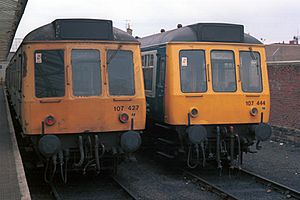British Rail Class 107 facts for kids
Quick facts for kids British Rail Class 107 |
|
|---|---|

Units 107 427 and 107 444 at Largs in April 1984
|
|
| In service | 1960 - 1991 |
| Manufacturer | BR Derby Works |
| Number built | 1960 |
| Formation | DMBS-TSL-DMCL |
| Operator(s) | British Rail |
| Specifications | |
| Car length | 17.7 m (58 ft 1 in) |
| Width | 2.81 m (9 ft 3 in) |
| Height | 3.77 m |
| Maximum speed | 70 mph (112 km/h) |
| Weight | 35.5 tonnes |
| Traction system | Diesel Mechanical |
| Prime mover(s) | Two BUT, 150 bhp |
| Safety system(s) | AWS |
| Track gauge | 1,435 mm (4 ft 8 1⁄2 in) |
The British Rail Class 107 was a type of train known as a diesel multiple unit. These trains were built by the Derby Works for British Rail and started running in 1960. They looked a lot like the later Class 108 trains. However, the Class 107s were made from steel, which made them heavier.
Contents
What Was the Class 107 Train?
The Class 107 was a special type of train. It was a diesel multiple unit, or DMU for short. This means it ran on diesel fuel and could drive itself. Unlike a train pulled by a separate engine, a DMU has its engines built right into the passenger cars. This made them flexible and efficient for many routes.
Building the Class 107
These trains were made in 1960 at the Derby Works. This was a big factory in England. It was known for building many different types of trains. The Class 107s were designed to be strong and reliable. They were built using steel, which made them quite sturdy. This also made them heavier than some other trains of their time.
Design and Features
The Class 107 trains had a similar look to the Class 108 trains. Both classes were designed for passenger service. However, the Class 107 was unique because of its steel body. This construction made them heavier. Each train could reach a top speed of 70 miles per hour (112 km/h). They were powered by two diesel engines. Each engine produced 150 horsepower.
Where Did the Class 107 Run?
The Class 107 trains were used across different parts of Britain. They were especially common in Scotland. Many people remember seeing them on lines around Glasgow. They also served routes in the north of England. These trains were important for local and regional journeys. They helped connect towns and cities.
Service Life and Routes
The Class 107 trains began their service in 1960. They worked hard for over 30 years. They carried passengers on many different routes. Their strong build helped them handle busy schedules. They were a familiar sight for many travelers. These trains were a key part of British Rail's fleet.
The End of Their Journey
After many years of service, the Class 107 trains were retired. They stopped running in 1991. Newer, more modern trains took their place. While they are no longer in service, they are remembered. They played an important role in British railway history. They helped many people travel across the country.

